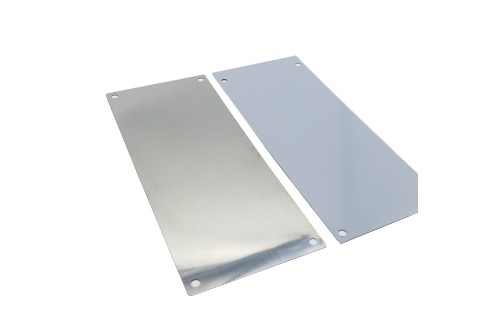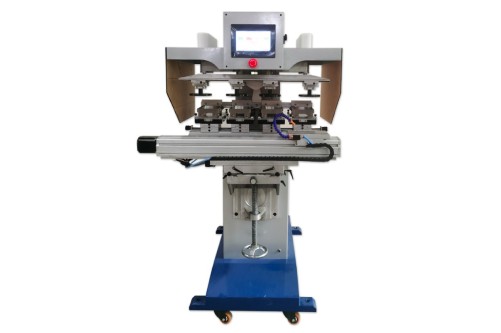Introduction
Pad printing is widely used across various industries due to its versatility and ability to print on irregular or curved surfaces. One critical component of the pad printing process is the pad printing cliche plate. These plates’ design features and engraving techniques are vital in optimizing ink transfer and registration accuracy. In this article, we will explore the key considerations and methods that can enhance the performance of pad printing cliche plates.
Design Features for Optimized Ink Transfer
Several design features should be considered when selecting pad-printing cliche plates to achieve optimal ink transfer during the pad-printing process. These features contribute to the efficient ink release from the plate’s surface, producing crisp and consistent prints.
Surface Texture and Topography Considerations
The surface texture of pad printing cliche plates significantly impacts ink retention and release. A carefully controlled surface roughness can help ensure an adequate amount of ink is transferred to the printing pad while preventing excess ink build-up. Micro-etched or laser-etched surfaces have gained popularity due to their ability to improve ink transfer.
Micro-etching involves creating tiny indentations on the plate’s surface, enhancing the ink’s adherence and promoting even distribution. Laser-etched containers, on the other hand, utilize laser technology to engrave precise patterns, optimizing ink flow and release. Both techniques offer advantages in terms of ink transfer efficiency and print quality.
Pattern and Geometry Optimization
Apart from surface texture, the pattern and geometry of the design on the pad printing cliche plate also play a crucial role in ink transfer and registration accuracy. The pattern’s shape, depth, and relief angles can significantly impact the distribution and coverage of ink on the printing pad.
Designers and manufacturers must consider the specific requirements of their printing application when optimizing the pattern and geometry. Factors such as the substrate’s size and shape, the ink’s viscosity, and the desired print resolution influence the design choices.
By carefully selecting and adjusting the pattern’s characteristics, it is possible to achieve consistent ink transfer and precise registration, leading to high-quality prints with sharp details and accurate colors.
Engraving Techniques for Enhanced Registration Accuracy
The engraving technique used on the pad printing cliche plate is another critical factor in achieving precise registration. Proper registration ensures that the printed image aligns accurately with the target area on the substrate, avoiding misalignment or overlapping.
Laser engraving and chemical etching are two commonly used engraving techniques in pad printing. Each method offers unique advantages and considerations.
Laser Engraving Technology
Laser engraving provides exceptional precision and flexibility when creating designs on pad-printing cliche plates. This technique utilizes laser beams to remove material from the plate’s surface, resulting in fine details and intricate patterns. The ability to control the laser’s intensity and duration enables precise control over the engraving depth, which is essential for achieving optimal registration accuracy.
Another advantage of laser engraving is its compatibility with various substrates and ink types. Laser-engraved plates can deliver consistent and reliable results, whether printing on plastics, metals, ceramics, or other materials.
Chemical Etching Methods
Chemical etching is another commonly employed technique for engraving pad printing cliche plates. This method involves controlled material removal through chemical processes, resulting in precise and consistent designs.
One key advantage of chemical etching is the ability to control the etch depth accurately. This control ensures the plate’s design aligns perfectly with the printing pad, enabling precise registration. The etching process can be tailored to different materials, allowing optimal performance on various substrates.
Manufacturers often choose between laser engraving and chemical etching based on their specific requirements, such as the complexity of the design, the desired registration accuracy, and the material properties.
By utilizing advanced engraving techniques, such as laser engraving or chemical etching, users can achieve enhanced registration accuracy and produce high-quality prints with excellent detail and color fidelity.
Next, discuss some real-world examples and case studies highlighting successful implementations of design features and engraving techniques for pad printing cliche plates.
Factors to Consider When Purchasing Cliche Plates
When it comes to purchasing pad printing cliche plates, several crucial factors should be taken into consideration. These factors can ensure that the chosen cliche plates meet the specific requirements of the printing application and deliver optimal performance.
Material Selection
The choice of material for pad printing cliche plates is essential for durability, longevity, and compatibility with different ink types. Common materials used for cliche plates include steel, aluminum, and photopolymer.
Steel cliche plates offer excellent durability and are suitable for high-volume production. They can withstand repeated use without compromising print quality. Due to their cost-effectiveness, aluminum cliche plates are often preferred for shorter print runs. Photopolymer plates, however, provide flexibility and ease of use, allowing for quick plate production and customization.
When selecting the material, it is crucial to consider the desired print volume, ink compatibility, and the printing environment’s conditions.
Customization Options
Cliche plates can be customized according to specific requirements, including size, shape, and thickness. The size and shape of the cliche plate should match the printing area and substrate dimensions to ensure proper ink transfer and registration.
Thickness customization is significant when working with substrates of varying heights or irregular surfaces. It allows for precise alignment between the printing pad and the substrate, resulting in accurate prints.
Working with a reputable manufacturer or supplier of pad printing cliche plates ensures access to a wide range of customization options and expert guidance in selecting the most suitable cliche plates for the application.
Supplier Expertise and Quality Assurance Processes
When purchasing pad printing cliche plates, partnering with a reliable and experienced supplier is essential. A trusted supplier will offer high-quality cliche plates and provide valuable technical support and guidance throughout the purchasing process.
Consider suppliers that have a strong reputation in the industry and demonstrate expertise in pad printing cliche plates. Look for suppliers who follow stringent quality assurance processes to ensure consistent product performance and adherence to industry standards.
Wholesale Pad Printing Cliche Plates
For bulk purchasing needs, wholesalers can be an excellent option. Wholesale suppliers offer competitive pricing and larger quantities of pad printing cliche plates. This can benefit businesses with high-volume printing requirements or those seeking cost-effective solutions.
Users can make informed decisions when purchasing pad printing cliche plates by carefully considering material selection, customization options, supplier expertise, and wholesale options. These factors contribute to achieving optimal ink transfer and registration accuracy, ultimately enhancing the overall printing quality.
Conclusion
The design features and engraving techniques employed on cliche plates are vital in optimizing ink transfer and registration accuracy in pad printing. By carefully considering these factors, users can achieve high-quality prints with sharp details and precise color reproduction.
Surface texture and topography, pattern and geometry optimization, and engraving techniques such as laser engraving and chemical etching all enhance ink transfer efficiency and registration accuracy. These techniques ensure consistent and reliable results across various substrates and ink types.
Real-world case studies and industry examples demonstrate the successful implementation of design features and engraving techniques, validating their effectiveness in improving print quality. By studying these examples, users can gain insights and inspiration for their printing applications.
When purchasing pad printing cliche plates, it is crucial to consider factors such as material selection, customization options, supplier expertise, and wholesale options. Choosing the suitable material, customizing the plate to match specific requirements, and partnering with a reputable supplier are critical steps in ensuring optimal performance and long-term satisfaction.
In conclusion, users can maximize ink transfer efficiency and achieve exceptional registration accuracy on pad printing cliche plates by understanding and implementing the appropriate design features and engraving techniques. This, in turn, leads to high-quality prints that meet the demands of diverse industries and applications.







